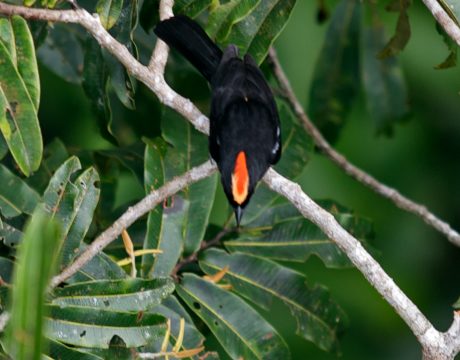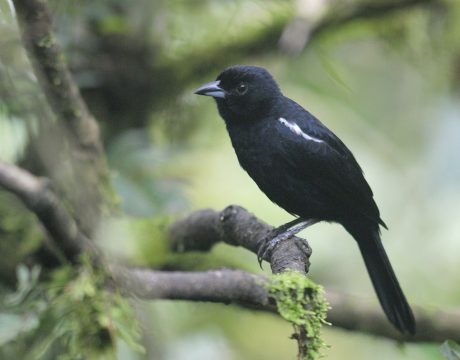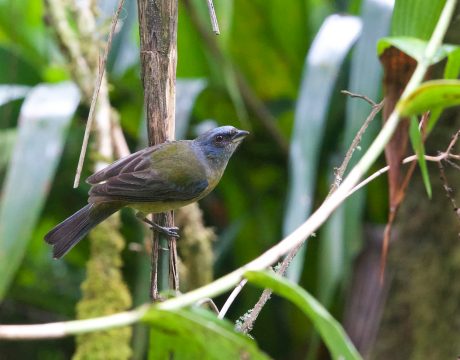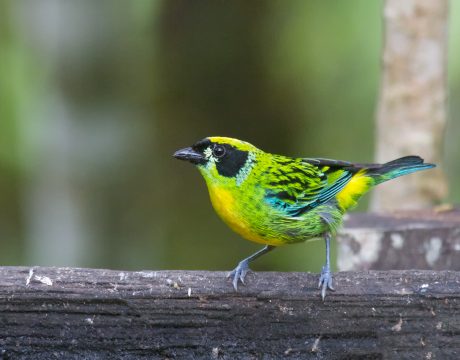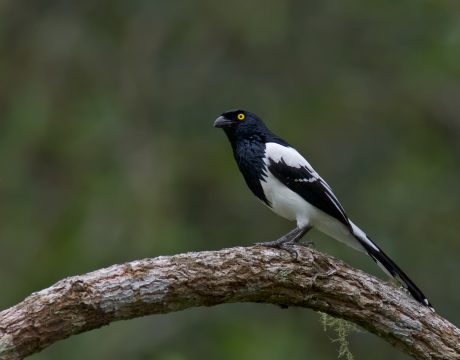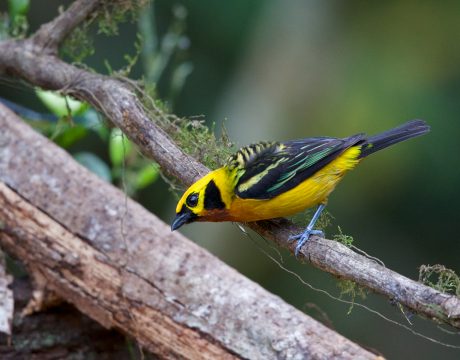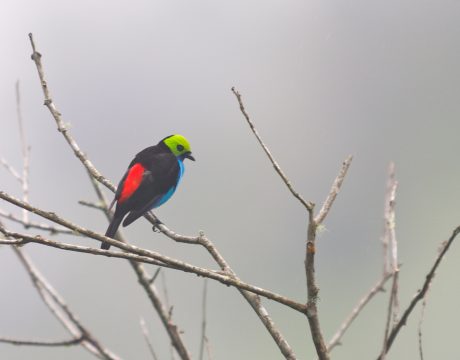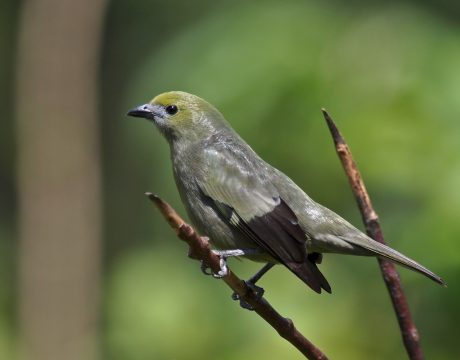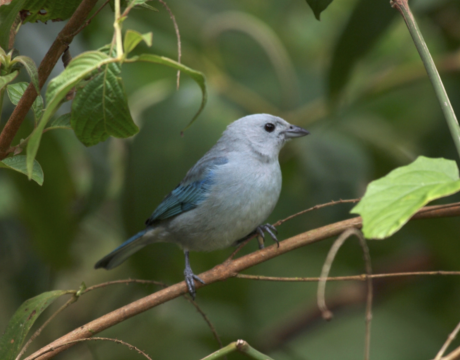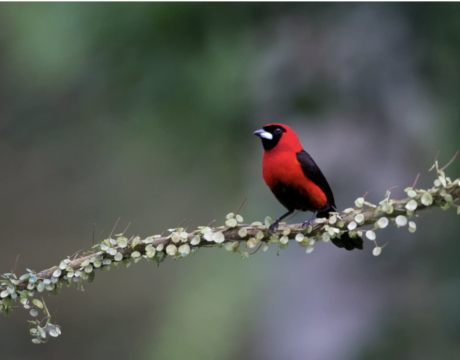Return of Bird of the Week: Flame-crested Tanager
Back in early May, when the Bird of the Week shifted to Tanagers, WC warned that there were dozens of species. Here’s the fifteenth. This is a species WC has only seen one time; it’s a canopy dweller, spending most of its time in the upper canopy, a hundred feet or more over the heads of would-be birders. A birder can get around that problem by visiting a canopy tower, a platform that takes you up into the tops of the trees (after a hot, sweaty climb of hundreds of steps, of course). Sometimes, as here, there are as many…
Return of Bird of the Week: White-lined Tanager
To some extent, the White-lined Tanager is an odd species. It is very widely distributed, ranging from Costa Rica to Argentina, and across the width of South America. There are isolated populations scattered in the Andes. Yet there are no subspecies. It is monotypic. It is strongly sexually dimorphic; the bright, rufous female looks unrelated to the jet-black male. Those white wing coverts are not usually visible in the field. Because it adapts well to deforested areas, its range and population is expanding. And its genus, Tachyphonus, has only three species. And, unusually for a tanager, the White-lined Tanager forages in mated…
Return of Bird of the Week: Blue and Yellow Tanager
This is a somewhat drabber tanager, but after last week’s bird almost anything is gong to look drab. This is a male Blue and Yellow Tanager, a widely distributed species found from Argentina northwest to Andean Ecuador. It’s a generalist, found in may kinds of habitats from scrubby edges and parks to pure forest of varied types. And frequently around fruit feeders; it’s an enthusiastic attendant to feeders. The species is identified by its blue head and wings, blackish or greenish back, and yellow underparts and rump; females are less colorful than males but show the same general pattern. Common and…
Return of Bird of the Week: Green-and-Gold Tanager
Another ridiculously colorful tanager, this one from Southern Ecuador. This is the Green-and-Gold Tanager. This is another one of those birds that, when you get it in your binoculars in good light, makes your eyes water. Only the Paradise Tanageris more colorful, and it isn’t as brightly colored. Most birders, seeing it for the first time, simply gasp. This species occurs one the easterly slopes of the Andes and in western Amazonia, where it is found from southeastern Colombia and southern Venezuela south to northern Bolivia and western Brazil. It is a fairly common species in the lowlands, typically found…
Return of Bird of the Week: Magpie Tanager
This bird looks familiar, doesn’t it? But looks can be deceiving. This isn’t a Black-billed Magpie with a weird yellow eye; this is a Magpie Tanager. It’s a fairly common bird of the South American lowlands, especially partially deforested and riverine areas. It’s monotypic: it’s the only species of the genus Cissopis.It’s also the longest tanager, thanks to that impressive tail. And, WC has to say, it acts an awful lot like a magpie, too. Active and noisy; the behavior of the Magpie Tanager is often described as “jay-like.” The birds quickly hop from branch to branch in denser brush….
Return of Bird of the Week: Golden Tanager
Okay, we’ve had a drab – well, subtle – Palm Tanager. We’ve had a ridiculously colorful Paradise Tanager. Let’s go back to a merely colorful tanager, this time the Golden Tanager. The Golden Tanager is distributed from northern Venezuela to southern Peru, with at least nine subspecies scattered across that range. It’s a bright, golden bird, with blue and yellow in its wings. You can see the much smaller black auricular patch, and the very different coloration in the wing in this subspecies. This might be the most variable of the tanager species WC has encountered. Golden Tanagers are about averaged-sized for…
Return of Bird of the Week: Paradise Tanager
The Paradise Tanager can be difficult to see. But it’s worth the effort. It’s a canopy species, rarely coming down from the top of the jungle forest. To see it, you either need to be in a canopy tower and hope the species wanders by, or on a road along a steep slope, so that downslope treetops are at eye level. This photo is an example of the latter. Not only is it a canopy-dweller; it’s as hyperactive as a North American Ruby-crowned Kinglet. It makes the species a real challenge to see, let alone photograph. The coloration almost looks…
Return of Bird of the Week: Palm Tanager
Not all tanagers are brightly colored, although many of them certainly are. Some have coloration that is a little more subtle, like the Palm Tanager. The Palm Tanager is one of the most widespread and familiar birds of humid lowland forests of the Neotropics, ranging from Nicaragua south to southern Brazil and in to the Caribbean. The Palm Tanageris similar in many ways to last week’s Blue-gray Tanager, although the Palm Tanageris less likely to be found in urban areas than the Blue-gray Tanager. Palm Tanagersare common at forest borders, but also occur in the canopy of the interior of forest….
Return of Bird of the Week: Blue-Gray Tanager
It might be the most widely distributed and common species of tanager. But it’s still a very handsome bird. At almost any location between southeastern Mexico and central South America, it’s a familiar presence at forest edges, in second-growth forests and along roads and rivers. It can even be found in urban parks and gardens. Blue-gray Tanagers prefer semi-open habitats; they are not found in interior of closed canopy forest, but they can quickly colonize fresh clearings. The habitat preference means they are one of the most common tanagers around human-impacted areas. They are flexible as well in their diet,…
Return of Bird of the Week: Masked Crimson Tanager
This species is another of nine members of the genus Ramphocelus, a cousin of last week’s Crimson-backed Tanager. This species is endemic to upper Amazonia and is rarely found far from water, for example. in várzea forest or oxbow lakes. It is usually found in groups, which generally keep reasonably low in the vegetation, and the species as a whole ranges from southeast Colombia south to northernmost Bolivia, and east into central Amazonian Brazil. The dramatic black mask and wing against the bright red body makes this an easy species to identify in the field. It’s usually found alone, but sometimes forages in…





